| m:
Abbreviation for meter. 39.37". |
| M:
Abbreviation for mega. One million or 106. |
| mA:
Abbreviation for milliamp. One thousandth of an
Amp or 10-3 Amps. |
| MAC:
Abbreviation for multiplexed analog components. A
video standard developed by the European community. An enhanced version,
HD-MAC delivers 1250 lines at 50 frames per second, HDTV
quality. |
|
Macrobending:
In a fiber, large macroscopic deviations of the fiber’s axis
from a straight line, that will cause light to leak out of the fiber,
causing signal
attenuation.
|
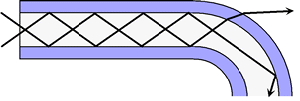 |
| MAN
(Metropolitan Area Network):
A network covering an area larger than a local area
network.
A series of local area networks, usually two or more, that cover a
metropolitan area. |
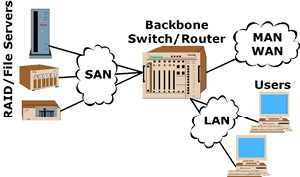
|
| MAP:
Abbreviation for manufacturing automation protocol. Computer programs
that run manufacturing automation systems. |
| Margin:
Allowance for
attenuation
in addition to that explicitly accounted for in system design. |
| Mass Splicing:
splicing
of many
fibers in
a cable.
|
| Material
Dispersion:
Dispersion
resulting from the different velocities of each
wavelength
in a material. |
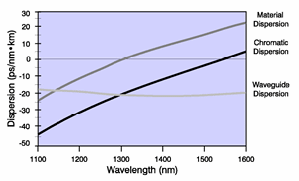
|
| MBaud:
One million symbols of information per second.
Equivalent to 1 Mb/s for binary signals. |
| Mean
Launched Power:
The average power for a continuous valid symbol sequence coupled into a
fiber.
|
| Mechanical
Splice:
An
optical fiber
splice
accomplished by fixtures or materials, rather than by thermal fusion.
The capillary splice, illustrated, is one example of a mechanical
splice. |

|
| Medium Access Control (MAC): 1) A service feature or technique
used to permit or deny use of the components of a communication system.
2) A technique used to define or restrict the rights of individuals or
application programs to obtain data from, or place data onto, a storage
device, or the definition derived from that technique. |
|
Mezzanine Compression: Contribution level quality
encoded
high-definition television signals. Typically split into two
levels: high level at 140 Mb/s and low level at 39 Mb/s. For high
definition within the studio, 270 Mb/s is being considered. |
|
MFD:
See mode field diameter.
|
| MH:
Abbreviation for medium-haul. A classification of
video performance under RS-250C. Higher performance than long-haul
and lower performance than short-haul.
|
| MHz:
Abbreviation for megahertz. One
million Hertz (cycles per second).
|
|
Microbending:
Mechanical stress on a fiber
that introduces local discontinuities, which results in light
leaking from the core
to the cladding
by a process called
mode coupling.
|

|
|
Microwave Dish: A parabolic shaped antenna used
for high-frequency RF signals. |
| Micrometer:
One millionth of a meter or 10-6
meters. Abbreviated µm. |
| Microsecond:
One millionth of a second or 10-6
seconds. Abbreviated µs. |
| Microwatt:
One millionth of a Watt or 10-6 Watts. Abbreviated µW. |
|
Microwave Transmission: Communication systems using very
high-frequency RF to carry the signal information. |
| MIL-SPEC:
Abbreviation for military specification. Performance specifications
issued by the Department of Defense. |
| MIL-STD:
Abbreviation for military standard. Standards
issued by the Department of Defense. |
|
Minimum Bend Radius: The smallest radius an optical
fiber or fiber cable can bend before increased attenuation or breakage
occurs. |
|
Misalignment Loss:
The loss of power resulting from
angular misalignment,
lateral displacement, and fiber end separation. |
|
MLM:
See multilongitudinal mode
laser.
|
| mm:
Abbreviation for millimeter. One thousandth of a
meter or 10-3 meters. |
|
MM:
See multimode.
|
|
Modal
Dispersion:
See multimode dispersion.
|
| Modal Noise:
Noise that occurs whenever the optical power propagates through
mode-selective devices. It is usually only a factor with laser
light sources. |
| Mode:
A single electromagnetic wave traveling in a fiber.
|
| Mode Coupling:
The transfer
of energy between modes. In a fiber,
mode coupling occurs until
equilibrium mode distribution
(EMD) is reached. |
| Mode Evolution:
The
dynamic process a multilongitudinal mode
laser
undergoes whereby the changing distribution of power among the modes
creates a continuously changing envelope of the laser's spectrum.
|
| Mode Field
Diameter
(MFD):
A measure of
distribution of optical power intensity across the end face of a
single-mode fiber.
See also
effective area. |
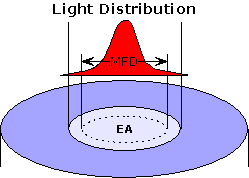
|
| Mode Filter:
A device that
removes higher-order modes to simulate
equilibrium mode distribution.
A mode filter is most easily constructed
|
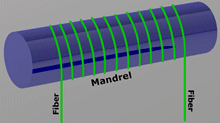
|
| Modem:
Acronym
for modulator/demodulator. 1) In general, a
device that both modulates and demodulates signals. 2) In computer
communications, a device used for converting digital signals into, and
recovering them from, quasi-analog signals suitable for transmission
over analog communications channels such as telephone lines. |
| Mode Scrambler:
A device that mixes modes to uniform power distribution. |

|
|
Mode Stripper:
A
device that removes
cladding modes.
|
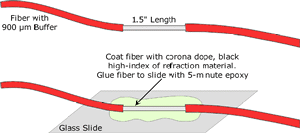
|
| Modulation:
The process by which the characteristic of one wave (the carrier)
modifies another wave (the signal). Examples include amplitude
modulation (AM),
frequency
modulation (FM),
and
pulse-coded modulation (PCM). |
|
Modulation Index:
In
an intensity-based system, the modulation index is a measure of how much
the modulation signal affects the light output. It is defined as
follows:
|

|
| Modulator:
A device that imposes a signal on a carrier. |
| Monitor:1) a CRT that receives its signal
directly from a VCR, camera, or separate TV tuner for high-quality
picture reproduction. 2) A device used for the real-time temporary
display of computer output data. 3) Software or hardware that is used to
scrutinize and to display, record, supervise, control, or verify the
operations of a system. |

|
| Monochrome:
Black and white TV signal. |
| Moore’s
Law: A prediction for the rate of
development of modern electronics. It states that the density of
information storable in silicon roughly doubles every year. Or, the
number of transistors on a chip will double every eighteen months, with
proportional decreases in cost and increases in performance. For more
than two decades this prediction has held true. Named after Gordon E.
Moore, physicist, cofounder and chairman emeritus of Intel Corporation.
|
|
Most Significant Bit: In a binary code, the bit or bit
position that is assigned to, or represents, the largest quantity or
increment that the code can represent. |
| MPEG:
Abbreviation for motion picture
experts group. An international standard for compressing video that
provides for high compression ratios. The standard has two
recommendations: MPEG-1 compresses lower-resolution images for
videoconferencing and lower-quality desktop video applications and
transmits at around 1.5 Mb/s. MPEG-2 was devised primarily for
delivering compressed television for home entertainment and is used at
CCIR
resolution when bit rates exceed 5.0 Mb/s as in hard disk-based
applications. |
|
MQW:
See multi-quantum well laser.
|
| ms:
Abbreviation for milliseconds. One thousandth of a second or 10-3
seconds. |
|
MSO:
Abbreviation for multiple service operator. A telecommunications company
that offers more than one service, e.g. telephone service, Internet
access, satellite service, etc. |
| MTBF:
Abbreviation for mean time between failure. Time
after which 50% of the units of interest will have failed. Also called
MTTF (mean time to failure).
|
|
Multilongitudinal Mode (MLM) Laser
: An
injection laser diode which has a number of longitudinal modes. |
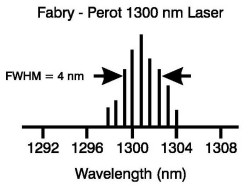
|
| Multimode
Dispersion:
Dispersion
resulting from the different transit lengths of different propagating
modes
in a multimode optical fiber. Also called modal dispersion. |
| Multimode (MM) Fiber:
An
optical fiber
that has a core large enough to propagate more than one mode of light
The typical diameter is 62.5 micrometers. |
 |
|
Multimode Laser Diode
(MMLD):
Synonym for
multilongitudinal mode laser. |
|
Multiple Reflection Noise
(MRN):
The fiber optic
receiver
noise resulting from the interference of delayed signals from two or
more reflection points in a fiber optic span. Also known as multipath
interference. |
|
Multiplexer:
A device that combines two or more signals into
one output. |

|
|
Multiplexing:
The process by which two or more signals are transmitted over a single
communications channel. Examples include
time-division multiplexing (TDM)
and
wavelength-division multiplexing (WDM). |
|
Multi-quantum Well (MQW) Laser:
A laser structure with a very thin (about 10 nm thick) layer of bulk
semiconductor material sandwiched between the two barrier regions of a
higher bandgap material. This restricts the motion of the electrons and
holes and forces energies for motion to be quantized and only occur at
discrete energies. |
| MUSE:
Abbreviation for multiple sub-Nyquist encoder. A high-definition
standard developed in Europe that delivers 1125 lines at 60 frames per
second. |
| mV:
Abbreviation for millivolt. One thousandth of a Volt or 10-3
Volts. |
| mW:
Abbreviation for milliwatt. One thousandth of a
Watt or 10-3 Watts. |
| MZ: Abbreviation for Mach-Zehnder, a
structure used in fiber Bragg
gratings and
interferometers. Named for the two men who
developed the underlying principles of the structure. |